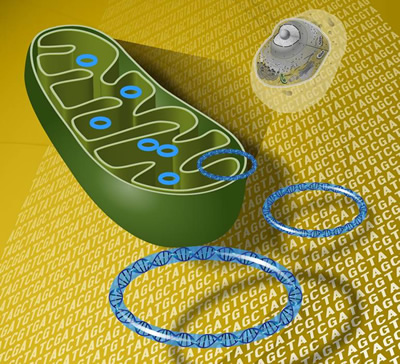Last updated: August 29, 2014
Researchers examine disease-causing mutations in mitochondrial genomes
Genome Advance of the Month
Researchers examine disease-causing mutations in mitochondrial genomes
By Kyle Davis
ScM Candidate, Genetic Counseling, JHU/NHGRI
The study of genetic disease has often centered on the human nuclear genome - the sprawling linear code of about 3.2 billion nucleotides and more than 24,000 genes spread across our 46 chromosomes. In contrast, the other genome that resides within us, the mitochondrial genome, has received less attention. Though our genome dwarfs it in size - a short, circular genome with just over 16,000 nucleotides and exactly 37 genes - the small (but mighty) mitochondria genome is arguably just as important.
Unlike the nuclear genome - where each cell has only one complete copy - there can be tens, hundreds or thousands of mitochondria per cell. Since each mitochondrion has on average five full mitochondrial genomes, there can, theoretically, be tens, hundreds or thousands of mitochondrial genomes per cell. New studies that sequence entire genomes have also sequenced our mitochondrial genomes, giving scientists a more detailed glimpse into the nature of diseases associated with mitochondrial mutations.
Mitochondria - often referred to as the "power plant of the cell" - are complex. They not only create energy in the form of the ever-present molecule adenosine triphosphate (ATP) used for many of the cell's actions, but they also house genes for the ribosome, which build proteins as well as the transfer RNA (tRNA) genes and provides a sort of lock-and-key system that helps decipher the genetic code into the amino acid protein code.
This way, mitochondria keep each cell humming (awash in ATP) and building proteins (with a steady supply of tRNA keys). If a mutation affects any of these genes, a person may experience a mitochondrial disease ranging from myopathy or epilepsy, to complex disorders including Type 2 diabetes, cancer, premature aging and neurodegenerative diseases. The word "may" is the complicating factor here.
When there is a mutation in a mitochondrial genome, it may be in only one mitochondrion in a cell, or the mitochondrion may have many exact copies, so the same mutation is seen in a few, some or most of the mitochondria in the cell or person. This is known as heteroplasmy - the focus of July's Genome Advance of the Month
Although it might sound strange, heteroplasmy is something that occurs in the vast majority of people - perhaps as high as 90 to 100 percent. But the precise prevalence, although academically interesting, does not tell scientists how the body deals with these mitochondrial mutations or inform healthcare workers the levels at which people may begin to suffer from a mitochondrial disease if they harbor mutations in their mitochondrial genome.
To begin answering these questions, a study in the journal, Proceedings of the National Academy of Sciences, examined disease-causing mutations in the mitochondrial genomes of otherwise healthy people and the levels of heteroplasmy that may lead to a mitochondrial disease. An international team of researchers based in the United States and China examined mitochondrial genomic data from the 1000 Genomes Project, an extensive catalog of human genetic variation of 1,085 healthy individuals from 14 different populations. After downloading the raw data, the team searched the data for variations, looking for both disease-causing mutations and benign changes (polymorphisms). To analyze the data, the researchers used a number of computational and statistical techniques to uncover uncommon or rare mutations observed in only one to 10 percent of the subjects' mitochondrial genomes.
Upon analysis, they found several striking results. First, they found that heteroplasmy is quite common -almost 90 percent of the subjects harbored one or more heteroplasmy. Second, they found that about seven percent of the heteroplasmies were associated with mitochondrial diseases, and furthermore, that one in five people carried at least one of these mitochondrial mutations, though at a very low level. Third, the team observed that if a mutation harmed delicate cellular machinery, the body might have a mechanism for filtering out mitochondria with the harmful mutation.
Delving into this last finding, the team noticed a pattern among the harmful heteroplasmies. The proportion of abnormal mitochondria decreased sharply when they reached about 60 percent. From this, they inferred that a level of 60 percent of harmful heteroplasmies might be a sort of threshold needed before a disease manifests in a person, and the point at which the body uses some method to remove them. Unfortunately, although the body does seem to reduce the amount of harmful heteroplasmies, it does so in an inefficient manner - possibly due to the small concentration of harmful heteroplasmies (fewer than 10 percent) that may be present in one's body.
This study was a general description of heteroplasmy. However, the study of heteroplasmy has wide-ranging implications that include better understanding the extent to which healthy people harbor disease-causing mutations in their mitochondrial genomes and the threshold of heteroplasmy needed before a mitochondrial disease manifests in a person.
Ultimately, this could help researchers understand the amount and type of mutations in mitochondria, how these may be inherited and if the body has a mechanism that protects itself against harmful heteroplasmies. If so, researchers in the future could possibly use such a mechanism as a target for therapeutic interventions to treat the diseases linked to mitochondrial malfunction.Read the Study
Ye K, Lu J, Ma F, Keinan A and Gu Z. Extensive pathogenicity of mitochondrial heteroplasmy in healthy human individuals. Proc Natl Acad Sci U S A, 111(29):10654-10659. 2014. [PubMed]Posted: August 29, 2014

